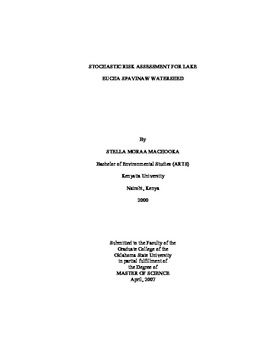| dc.contributor.advisor | Stoecker, Arthur | |
| dc.contributor.author | Machooka, Stella Moraa | |
| dc.date.accessioned | 2014-04-15T22:31:44Z | |
| dc.date.available | 2014-04-15T22:31:44Z | |
| dc.date.issued | 2007-04-01 | |
| dc.identifier.uri | https://hdl.handle.net/11244/9560 | |
| dc.description.abstract | This study tests the feasibility of developing a risk programming (optimization) model directly from the outputs of a biophysical simulation model to determine the most efficient locations for non-point source abatement in a watershed. The SWAT (Soil Water Assessment Tool) simulation model with 60 years of weather data is used to estimate biomass consumption by cattle and phosphorus runoff from seven levels of litter application. Then a Target MOTAD model with 60 years of phosphorus runoff was used to determine the cost and the management practices that should be used in each area of the watershed so average Phosphorus loadings and the deviations of these loading above alternative phosphorus loss targets (possible TMDLs) are met. The ability to put a limit on deviations above a pollution target provides an estimate of the costs associated with the margin of safety associated with setting a TMDL in a watershed. The feasibility of developing a Target MOTAD optimization model, directly from outputs of a simulation model developed and calibrated by hydrologists that could determine the most efficient management practices, under stochastic conditions for each sub area within a watershed is demonstrated. The cost of reducing phosphorus runoff varies significantly between soil types. It is found that for some soils zero litter applications (no fertilizer) actually increases phosphorus loss through erosion of soil sediments. It is optimal to apply more litter to some soils than to others which implies that policies based on non uniform limitations are the most cost effective. The cost of reducing phosphorus runoff from the watershed increased rapidly as attempts were made to reduce annual loadings by more than 15 Mg per year. | |
| dc.format | application/pdf | |
| dc.language | en_US | |
| dc.publisher | Oklahoma State University | |
| dc.rights | Copyright is held by the author who has granted the Oklahoma State University Library the non-exclusive right to share this material in its institutional repository. Contact Digital Library Services at lib-dls@okstate.edu or 405-744-9161 for the permission policy on the use, reproduction or distribution of this material. | |
| dc.title | Stochastic Risk Assessment for Lake Eucha Spavinaw Watershed | |
| dc.type | text | |
| dc.contributor.committeeMember | Boyer, Tracy | |
| dc.contributor.committeeMember | Smolen, Michael | |
| osu.filename | Machooka_okstate_0664M_2299.pdf | |
| osu.college | Agricultural Sciences and Natural Resources | |
| osu.accesstype | Open Access | |
| dc.description.department | Environmental Sciences Program | |
| dc.type.genre | Thesis | |
| dc.subject.keywords | lake eucha spavinaw | |
| dc.subject.keywords | watershed | |
| dc.subject.keywords | phosphorus non-point pollution | |
| dc.subject.keywords | target motad | |
| dc.subject.keywords | swat | |
| dc.subject.keywords | stochastic risk assessment | |
